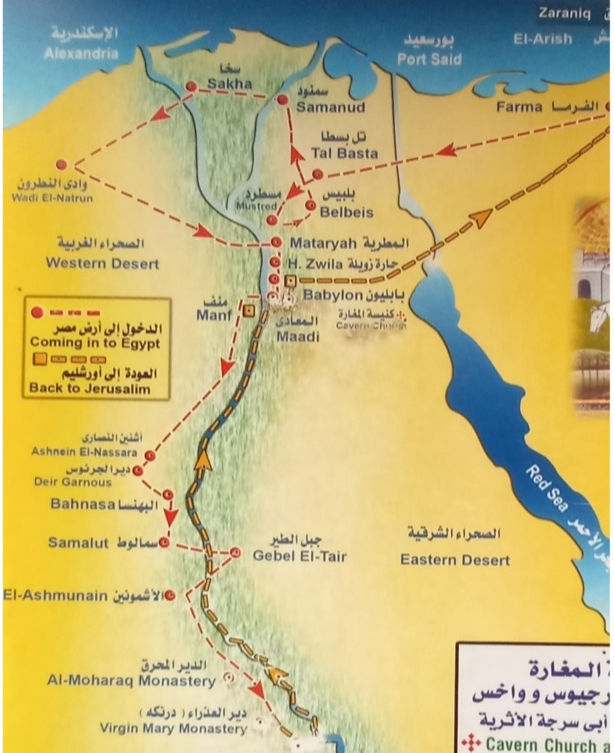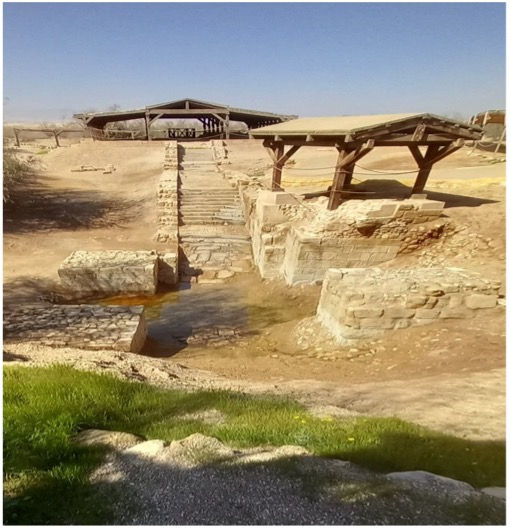Will Alkass writes about a trip to Jordan and Egypt last year
Many people associate the Holy Land with places mentioned in the Old and New Testaments; that is Israel and Palestine notably the cities of Jerusalem, Nazareth, Bethlehem, Jericho, the Sea of Galilee and others. However, there are many other places to be found in the neighbouring countries, Jordan and Egypt, which are as important to the Christian faith and to any person wishing to visit some or all of them as sites of pilgrimage. During a trip to Jordan and Egypt in February 2023, I and my wife Hannah as intrepid tourists were lucky to have the good fortune of visiting some of these places.
Mount Nebo, where Moses stood looking at the Promised Land
This place is mentioned in the Old Testament (Deuteronomy, 34:6 and 2 Maccabees, 2:4 – 7) as the spot in old Moab where Moses stood and looked over the horizon across the Jordan River to the Promised Land, having led his people from captivity in Egypt through Sinai desert to freedom. Unfortunately Moses, according to God's will, did not make it to the Promised Land, as he died there and was buried in a hitherto undiscovered tomb. His brother, Aaron, completed the task.
Pilgrims to the site can visit a modern basilica which was constructed over an ancient basilica and monastery from the 4th century housing the original well-preserved and beautiful floor mosaic.
On top of a nearby spot is a modern symbolic representation of the bronze snake that Moses made to save his people from poisonous snakes (which were attacking them as punishment from God for their ingratitude and their impatience to Moses and to God while waiting to return to the Promised Land (Numbers 21:4-9))
Mount Nebo has an elevation of about 1000 meters above the desert surface and lies some 35 minutes to the east of the Dead Sea. On a clear day, you can actually see the Holy Land, the Dead Sea, the city of Jericho, Bethlehem and Jerusalem across the Jordan River.
The Trail of The Holy Family in Egypt

The Holy Family's journey through Lower and Upper Egypt has always been well known to the local population, the faithful followers of the Coptic Orthodox Church. At each of the 25 locations where the family stopped to rest, a church or monastery was built in antiquity to commemorate the site for eternity. At many of these sites in the middle of what was a desert, a Well is believed to have sprung for the family to quench their thirst and wash. Needless to say, many legends and stories of miracles happening at these sites, old and new, continue to draw many people hoping for healing and heavenly visions and the answering of all manner of appeals.


We were lucky to be able to visit one of these sites located in Cairo's suburb. The cave where the holy family is believed to have sheltered for some time is now located near a complex of churches and monasteries, the most famous of which is the “Hanging Church” (so called because it was built above the gatehouse of the Roman Babylon Fortress in Coptic Cairo, with the nave suspended over a passage).
Outside there is a very old twisted Sycamore tree that is said to have offered the Holy Family some shade. It has to be mentioned that with the passing of two thousand years, the exact route and locations of each of these sites can't be verified between chronicled history and myth. However one thing is certain, visiting these sites now is much easier than before, thanks in part to Egypt's Ministry of Tourism and Antiquity working in association with various Dioceses and charities to develop and promote the celebrated route which totals some 3000 km, with paved roads and accommodations and proper signage to bolster the country's image of its claim to Christian history and fame.
The Baptismal Site
The baptism of Jesus by John The Baptist is described in all the canonical Bibles and it heralds the start of Jesus' ministry and the birth of the Christian faith. After many years of uncertainty as to the exact location of the site, made by opposing claims on the part of the Jordanian and the Israeli authorities for obvious reasons, it has been accepted that the actual site of the baptism is situated on the east bank of the river Jordan just a few miles north of the dead sea in what is known as “Bethany beyond the Jordan”.

The whole area has been declared a UNESCO World Heritage Site in 2015 after taking into account many historical, archaeological and indeed Biblical facts, as well as 2 Papal visits to the area. A reference in the Bible (John 1:26 – 28) points unequivocally to the site, while later references confirm the location of places, such as The Madaba Map and the building of many Byzantine and Roman churches, chapels and monasteries, and the discovery of caves where many monks are believed to have lived in antiquity. There are several churches in the area, most notably the gold-domed Greek Orthodox Church of St. John The Baptist.

We have had the opportunity to visit both banks of the river, the Israeli side a few years ago and now the Jordanian side; and it's worth noting that the Israeli side receives many more pilgrims wishing to be baptised in the river than the Jordanian side.
Visiting these sites only became possible after the signing of the peace treaty between Jordan and Israel in 1994 followed by the clearing of landmines from the banks of the river.

Comments